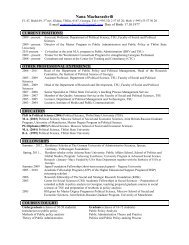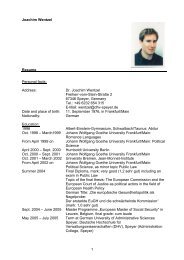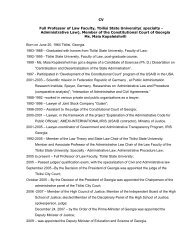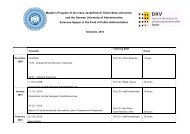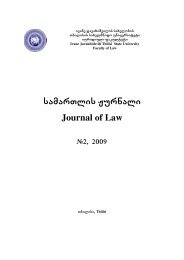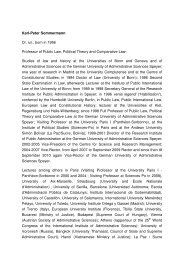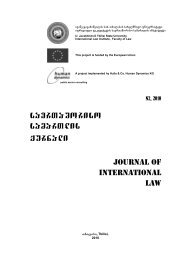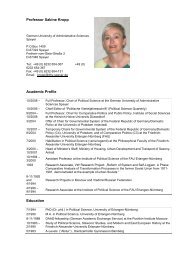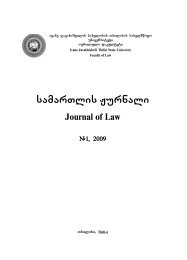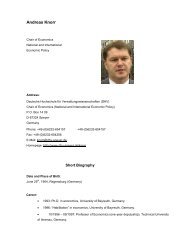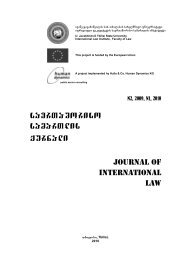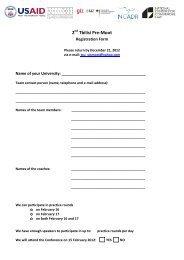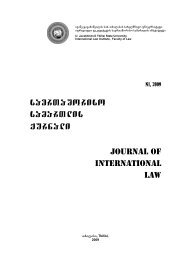Untitled
Untitled
Untitled
Create successful ePaper yourself
Turn your PDF publications into a flip-book with our unique Google optimized e-Paper software.
saerTaSoriso samarTlis Jurnali, #1, 2008 JOURNAL OF INTERNATIONAL LAW, N1, 2008<br />
tions Connection with International Migration of Workers and Members of Their<br />
Families, 7. Application of the Convention, 8. General Provisions, 9. Final Provisions.<br />
8<br />
In particular, Article 2, paragraph 1 of the Convention provides for the migrant<br />
worker as “a person who is to be engaged, is engaged or has been engaged in<br />
a remunerated activity in a State of which he or she is not a national”.<br />
9<br />
Please see International “Covenant on Economic, Social and Cultural Rights”,<br />
International “Covenant on Civil and Political Rights”.<br />
10<br />
Office of the United Nations High Commissioner for Human Rights, The International<br />
Convention on Migrant Workers and its Committee, Fact Sheet No. 24<br />
(Rev.1), p. 10.<br />
11<br />
The Committees are the monitoring bodies of the implementation of the UN<br />
human rights basic treaties (International Covenant “on Civil and Political Rights”<br />
of 1966 (with its optional protocols) International Covenant on “Economic, Social<br />
and Cultural Rights” of 1966, the Convention “on the Elimination of all forms of<br />
Racial Discrimination” of 1965, The Convention “on the Elimination of all Forms<br />
of Discrimination against Women” of 1979, the Convention “against Torture and<br />
Other Cruel, Inhuman or Degrading Treatment or Punishment” of 1984, the Convention<br />
“on the Rights of Child” of 1989, International Convention “on the Protection<br />
of the Rights of All Migrant Workers and Members of Their Families” of 1990).<br />
There are seven committees on the protection of the human rights, which are<br />
created for the monitoring of implementation of the Provisions of relevant Treaties.<br />
12<br />
After the ratification by 20 countries.<br />
13<br />
There are seven committees on the protection of the human rights in the UN.<br />
They examine the state reports, individual claims and applications, publish general<br />
comments, which basically relates to the issues and interpretation of the<br />
working principles. There is also procedure of the meetings of Chairmen of the<br />
Committees and inter-committees. The function of each committee is to monitor<br />
the implementation of provisions of the seven basic treaties of the UN, in particular:<br />
Human Rights Committee (HRC) supervises the monitoring process of<br />
International Covenant “on Civil and Political Rights” (with its optional protocols)<br />
of 1966, Committee on Economic, Social and Cultural Rights (CESCR) - International<br />
Covenant “on Economic, Social and Cultural Rights” of 1966, Committee<br />
on the Elimination of Racial Discrimination(CERD) - Convention “on the Elimination<br />
of all Forms of Racial Discrimination” of 1965, Committee on the Elimination<br />
of Discrimination Against Women (CEDAW) - Convention “on the Elimination<br />
of all Forms of Discrimination Against Women” of 1979, The Committee Against<br />
Torture (CAT) - Convention “against Torture and Other Cruel, Inhuman or Degrading<br />
Treatment or Punishment” of 1984, The Committee on the Rights of the Child<br />
(CRC) - The Convention “on the Rights of the Child” of 1989, The Committee on<br />
Migrant Workers - Convention “on the Protection of the Rights of all Migrant Workers<br />
and Members of Their Families” of 1990.<br />
14<br />
Office of the High Commissioner for Human Rights – main body working for the<br />
protection and popularization of Human Rights was established in 1946 (by the<br />
UN Economic and Social Council). The functions of the Commissioner includes:<br />
protection of the human rights throughout the word, monitoring, its development,<br />
popularization and codification of human rights as well.<br />
15<br />
Currently committee consists with 10 independent experts. The amount of the<br />
experts will increase after the entry into force of the Convention for the forty-first<br />
State Party, of fourteen experts. The Members of the Committee shall be elected<br />
by secret ballot by the States Parties, due consideration being given to equitable<br />
geographical distribution including both States of origin and States of employment<br />
of the migrant workers. The members of the Committee shall serve for a<br />
term of four years. Half of the members of the Committee are elected once in two<br />
years. Their term of office starts at January 1 of each year and ends at December<br />
31 of the forth year (in accordance with Article 72, paragraph 5, sub-paragraph a)<br />
of the Convention). Exceptional case is when the Convention will enter into force<br />
for the forty-first State Party and additionally four experts will be elected. From<br />
these experts two members shall be chosen by the Chairman of the meeting on<br />
the basis of secret ballot. They shall serve for a tern of two years. (Article 72,<br />
148



